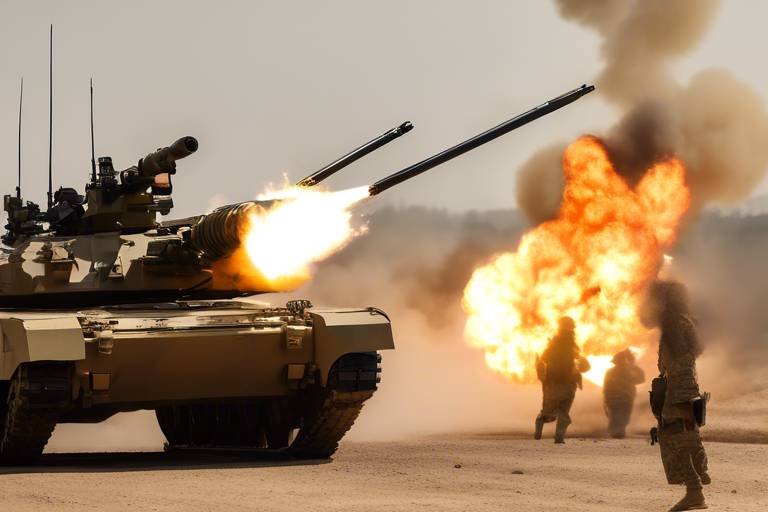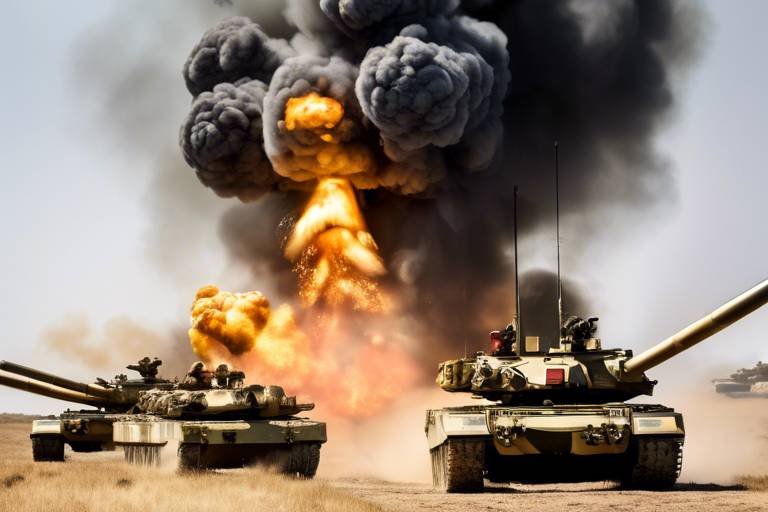How Firepower is Coordinated in Joint Strike Operations
In today's complex battlefield, the coordination of firepower in joint strike operations is more crucial than ever. Imagine a symphony orchestra, where each musician plays a different instrument, yet they all come together to create a harmonious piece of music. Similarly, in military operations, various branches of the armed forces—like the Army, Navy, and Air Force—must collaborate seamlessly to achieve a common objective. This article explores the intricacies of this coordination, emphasizing the strategies and technologies that make it possible, as well as the essential roles played by different military units.
Joint strike operations are defined as coordinated military actions involving multiple branches of the armed forces working together towards a unified goal. The purpose of these operations is not just to enhance combat effectiveness but also to ensure that resources are utilized efficiently. Think of it as a well-oiled machine where every part must function correctly for the entire system to work effectively. The significance of joint strike operations in modern warfare cannot be overstated; they allow for a more flexible response to threats and can significantly increase the chances of mission success.
At the heart of effective firepower coordination lies robust command and control (C2). This structure is essential for ensuring that all military units can communicate and make informed decisions quickly. In joint operations, C2 involves a complex web of communication channels, decision-making processes, and leadership hierarchies. Without effective C2, the risk of miscommunication and operational failure skyrockets, much like a ship navigating through a storm without a captain.
To facilitate real-time coordination, military operations rely heavily on advanced communication systems. These systems enable seamless information exchange between various units, ensuring that everyone is on the same page, whether they are on land, at sea, or in the air. Technologies such as satellite communications, secure radios, and digital messaging platforms play a pivotal role in this aspect. For instance, imagine a general coordinating an airstrike while simultaneously receiving updates from ground troops; this level of communication is vital for success.
In the realm of joint operations, protecting sensitive information is paramount. Secure networks are essential for maintaining operational integrity and preventing enemy interception. Cybersecurity measures are implemented to safeguard communication channels, ensuring that vital data remains confidential. Without these secure networks, the risk of information leaks could jeopardize entire missions, much like a fortress without walls.
Data sharing platforms enhance situational awareness among various military forces. These tools allow for the dissemination of intelligence and operational data, providing commanders with real-time insights into the battlefield. By utilizing platforms that integrate data from various sources, military leaders can make informed decisions that significantly improve operational effectiveness. For example, a data-sharing platform can provide a comprehensive overview of enemy positions, allowing for more strategic planning of attacks.
Maximizing effectiveness in joint operations requires the seamless integration of various firepower assets. This involves synchronizing air, land, and naval forces to create a unified front against adversaries. Each branch of the military brings unique capabilities to the table, and when these strengths are combined, the result is a formidable force. Picture a chess game where each piece has its own role; when played correctly, they work together to checkmate the opponent.
The landscape of warfare has been dramatically transformed by advancements in technology, particularly concerning firepower coordination. Modern tools, such as drones and precision-guided munitions, have revolutionized how military operations are conducted. These technologies not only enhance the effectiveness of joint strike operations but also minimize risks to both military personnel and civilians.
Precision-guided munitions (PGMs) have become a game-changer in modern warfare. These advanced weapons significantly improve target accuracy, allowing military forces to strike with precision while minimizing collateral damage. In joint strike operations, the use of PGMs ensures that the intended targets are neutralized with minimal risk to surrounding areas. This level of accuracy is akin to a surgeon performing a delicate operation, where every move counts and precision is critical.
Drones have emerged as pivotal assets in reconnaissance and strike capabilities within joint operations. Their ability to gather real-time intelligence and deliver precise strikes makes them invaluable on the battlefield. Integrating drones into joint operations enhances decision-making processes, as commanders can access up-to-date information about enemy movements and positions. Think of drones as the eyes in the sky, providing a bird's-eye view of the battlefield and enabling more informed tactical decisions.
- What are joint strike operations? Joint strike operations involve multiple military branches collaborating to achieve a common objective in warfare.
- Why is command and control important? Effective command and control ensures seamless communication and decision-making among diverse military units, which is crucial for operational success.
- How do technology advancements impact firepower coordination? Technologies like drones and precision-guided munitions enhance the effectiveness and accuracy of joint operations while minimizing risks.
Understanding Joint Strike Operations
Joint strike operations are a fascinating aspect of modern military strategy, where multiple branches of the armed forces collaborate to achieve a common goal. Imagine a well-orchestrated symphony, where each instrument plays its part in harmony, creating a powerful and unified sound. That's precisely how joint operations work—each military branch, whether it be the Army, Navy, Air Force, or Marine Corps, brings its unique capabilities to the table, contributing to a cohesive operational effort.
The primary purpose of joint strike operations is to enhance combat effectiveness through synergy. When forces from different branches work together, they can leverage their strengths and compensate for each other's weaknesses, resulting in a more formidable fighting force. For instance, while air support can provide aerial reconnaissance and precision strikes, ground troops can secure and hold territory. This collaborative approach not only maximizes firepower but also improves situational awareness, ensuring that decisions are made based on real-time intelligence.
In today's complex battlefield, the significance of these operations cannot be overstated. As threats evolve and become more sophisticated, the ability to coordinate effectively across various military units becomes crucial. The integration of diverse capabilities allows for a more comprehensive response to challenges, whether they arise from conventional warfare or asymmetric threats, such as terrorism. In essence, joint strike operations embody the principle that "together we are stronger," enabling forces to adapt and respond swiftly to dynamic combat environments.
To illustrate the importance of joint strike operations, consider the following key elements:
- Shared Objectives: All participating branches must have a clear understanding of the mission goals, ensuring alignment in their efforts.
- Resource Allocation: Effective distribution of resources, such as personnel and equipment, is vital for achieving operational success.
- Training and Familiarization: Regular joint exercises help build trust and familiarity among different branches, enhancing coordination during actual operations.
Ultimately, understanding joint strike operations is about recognizing the intricate dance of military collaboration. It's not just about individual prowess but about how well these diverse forces can come together to achieve a common objective. By fostering communication, trust, and shared understanding, military leaders can ensure that their joint operations are not only successful but also set a benchmark for future collaborations.
The Role of Command and Control
In the chaotic theater of modern warfare, the role of command and control cannot be overstated. Imagine trying to orchestrate a symphony where each musician is from a different band, playing different instruments. That's what coordinating firepower in joint strike operations feels like. Command and control (C2) structures are the backbone that ensures all military branches—be it the Army, Navy, or Air Force—harmonize their efforts to achieve a common goal. The effectiveness of these operations hinges on how well these diverse units communicate and collaborate in real-time.
At the heart of effective C2 is a well-defined hierarchy that facilitates quick decision-making and clear communication. Commanders must have the right information at their fingertips to make split-second decisions that could mean the difference between success and failure. This structure is usually layered, comprising strategic, operational, and tactical levels. Each layer plays a critical role in ensuring that information flows seamlessly from the battlefield to the command center and back. For instance, tactical units on the ground need immediate support from air assets, while operational commanders require a broader picture of the battlefield to allocate resources effectively.
Robust communication systems are the lifeblood of any joint operation. Think of them as the arteries that carry essential information throughout the military body. These systems utilize advanced technologies and protocols to ensure that messages are relayed without delay. Whether it's voice communications, data sharing, or video feeds, every second counts. For example, during a joint exercise, real-time communication allows ground troops to call for air support precisely when they need it, significantly increasing the chances of mission success.
However, all this communication needs to be secure. The importance of cybersecurity in joint operations cannot be ignored. Just as a fortress protects its treasures, secure networks safeguard sensitive information from adversaries. Military forces employ various measures to protect their communication channels, including encryption and intrusion detection systems. This ensures that even if an enemy tries to intercept communications, they are met with a wall of security that keeps operational integrity intact.
In addition to secure networks, data sharing platforms play a pivotal role in enhancing situational awareness among forces. These platforms allow for the rapid dissemination of intelligence and operational data, ensuring that all units are on the same page. Imagine a digital map where every troop movement and enemy position is updated in real-time. This level of awareness is crucial for making informed decisions during high-stakes operations.
To illustrate the effectiveness of these systems, consider the following table that outlines the various components of command and control in joint strike operations:
| Component | Description | Importance |
|---|---|---|
| Command Hierarchy | Structured levels of command that facilitate decision-making | Ensures clarity and efficiency in operations |
| Communication Systems | Technologies that enable real-time information exchange | Critical for timely responses and coordination |
| Secure Networks | Systems that protect sensitive military information | Maintains operational security |
| Data Sharing Platforms | Tools for disseminating intelligence | Enhances situational awareness |
In summary, the role of command and control in joint strike operations is multifaceted and vital. It not only dictates how forces communicate but also influences the overall effectiveness of military strategies. By ensuring that all units are coordinated and informed, command and control structures pave the way for successful missions, allowing military forces to respond swiftly and decisively in the face of challenges.
Communication Systems
In the realm of joint strike operations, serve as the backbone for effective coordination. Imagine trying to orchestrate a symphony where each musician plays a different tune; without a conductor, chaos reigns. Similarly, the success of military operations hinges on seamless communication among various branches of the armed forces. Robust communication systems ensure that critical information flows smoothly, allowing for real-time decision-making and operational synchronization.
These systems encompass a variety of technologies and protocols designed to facilitate information exchange. For instance, satellite communications provide a reliable means for units to communicate over vast distances, while secure radio networks allow for direct, encrypted conversations between ground forces and air support. The integration of these technologies is crucial, as it enables forces to share intelligence, coordinate movements, and respond to evolving battlefield conditions swiftly.
Moreover, the importance of interoperability cannot be overstated. Different military branches often utilize distinct communication systems, which can lead to challenges during joint operations. To mitigate these issues, standardized protocols are established, allowing for effective interaction between air, land, and naval forces. This interoperability is like a universal translator in a sci-fi movie, breaking down language barriers and ensuring that everyone is on the same page.
To illustrate the complexity and necessity of these systems, consider the following table that outlines key communication technologies used in joint strike operations:
| Technology | Purpose | Benefits |
|---|---|---|
| Satellite Communications | Long-range communication | Reliable and global coverage |
| Secure Radio Networks | Direct communication between units | Encrypted and secure conversations |
| Data Link Systems | Real-time data sharing | Enhanced situational awareness |
| Mobile Communication Units | On-the-ground communication | Flexibility and mobility in operations |
In addition to the technologies themselves, the protocols governing their use are equally important. These protocols dictate how information is transmitted, received, and acted upon, ensuring that all units can operate cohesively. For example, during a joint strike operation, an air unit may identify a target and relay that information to ground forces. Without a clear communication protocol, that information could be misinterpreted or delayed, resulting in missed opportunities or, worse, friendly fire incidents.
In conclusion, effective communication systems are not just a luxury but a necessity in joint strike operations. They serve as the lifeline that connects various military branches, enabling them to act swiftly and decisively in the face of adversity. As technology continues to evolve, so too will the methods and systems we employ to ensure that our forces remain synchronized and capable of achieving their objectives.
Secure Networks
In the complex landscape of joint strike operations, serve as the backbone for effective communication and operational success. Imagine a bustling city where every vehicle needs to communicate with one another to avoid collisions and ensure smooth traffic flow; this is akin to how military units interact in the field. The stakes are incredibly high, and the need for reliable, secure channels of communication cannot be overstated. These networks are designed to protect sensitive information from falling into the wrong hands, ensuring that operational integrity is maintained throughout the mission.
To achieve this level of security, military forces implement a variety of sophisticated technologies and protocols. Encryption, for instance, acts as a digital lock on communication channels, making it nearly impossible for unauthorized users to decipher the data being transmitted. In addition to encryption, multi-factor authentication is employed to further safeguard access to critical systems. This means that even if a malicious actor manages to obtain a password, they would still face additional layers of security that must be breached.
Moreover, the importance of cybersecurity in joint operations cannot be overlooked. As military operations become increasingly reliant on digital communications, the potential for cyber threats grows exponentially. Hackers and adversarial nations are constantly probing for vulnerabilities, which is why military organizations invest heavily in defensive measures. Regular security audits and continuous monitoring of network traffic are essential practices that help identify and mitigate potential threats before they can escalate into serious issues.
In addition to protecting against external threats, secure networks also facilitate the seamless sharing of intelligence and operational data among various branches of the military. This is where data sharing platforms come into play. These platforms allow for real-time updates and collaboration across different units, enhancing situational awareness and ensuring that all forces are on the same page. The integration of these platforms into secure networks means that information can flow freely and safely, empowering commanders to make informed decisions on the fly.
In summary, secure networks are not just a luxury but a necessity in the realm of joint strike operations. They ensure that communication remains intact, protect vital information from cyber threats, and enable effective collaboration among diverse military units. As technology continues to evolve, so too will the methods for securing these networks, ultimately leading to more successful missions and enhanced operational effectiveness.
Data Sharing Platforms
In the realm of joint strike operations, are the unsung heroes that enhance situational awareness and ensure that all military branches are on the same page. Imagine a bustling control room where various military leaders are huddled around screens, each displaying real-time data from different fronts. This is the power of effective data sharing. These platforms enable the seamless exchange of intelligence and operational data, allowing for quick decision-making and coordinated actions.
One of the most significant advantages of data sharing platforms is their ability to aggregate information from diverse sources. For instance, information from satellite imagery, reconnaissance drones, and ground intelligence can be compiled and analyzed to create a comprehensive operational picture. This is not just about having access to data; it’s about transforming that data into actionable insights. The ability to see the battlefield from multiple perspectives can be the difference between success and failure in a joint operation.
Moreover, these platforms are designed to be user-friendly and accessible to personnel across various military branches. Whether it's the Army, Navy, Air Force, or Marines, everyone can tap into the same reservoir of information. This cross-branch accessibility is crucial because it fosters a culture of collaboration and trust, allowing for synchronized efforts that are essential in high-stakes environments.
Additionally, the integration of advanced technologies such as artificial intelligence and machine learning into data sharing platforms is revolutionizing how military operations are conducted. These technologies can analyze vast amounts of data at lightning speed, identifying patterns and anomalies that human operators might miss. This capability not only enhances situational awareness but also aids in predictive analysis, helping commanders anticipate enemy movements and adjust strategies accordingly.
However, with great power comes great responsibility. The security of these data sharing platforms is paramount. Sensitive information must be protected from cyber threats that could compromise operational integrity. To address this, military forces implement stringent cybersecurity measures, ensuring that communication channels remain secure and resilient against potential attacks. This vigilance is crucial, as the integrity of shared data directly impacts the effectiveness of joint operations.
In summary, data sharing platforms are a cornerstone of effective firepower coordination in joint strike operations. They not only facilitate the real-time exchange of critical information but also enhance collaboration among diverse military branches, ensuring that every unit is equipped with the knowledge needed to execute their missions successfully.
- What are data sharing platforms in military operations? Data sharing platforms are systems that allow different military branches to exchange intelligence and operational data in real-time, enhancing situational awareness and decision-making.
- How do data sharing platforms improve operational efficiency? By aggregating information from various sources and providing a comprehensive operational picture, these platforms enable quick and coordinated actions among military units.
- What technologies are integrated into data sharing platforms? Advanced technologies such as artificial intelligence and machine learning are often integrated into these platforms to analyze data quickly and accurately.
- How is the security of data sharing platforms ensured? Military forces implement stringent cybersecurity measures to protect sensitive information and maintain the integrity of communication channels.
Integration of Firepower Assets
When it comes to joint strike operations, the is not just a buzzword; it’s the backbone of effective military strategy. Imagine a well-orchestrated symphony where each musician plays their part in harmony to create a beautiful melody. Similarly, in military operations, various branches of the armed forces—air, land, and naval—must work together seamlessly to achieve a common goal. This integration is crucial for maximizing effectiveness and ensuring that every available resource is utilized to its fullest potential.
To illustrate this point, consider the different roles each military branch plays in a joint strike operation. The air force provides the aerial superiority needed to dominate the skies, while the navy secures maritime routes and conducts operations from the sea. On the other hand, the army is responsible for ground maneuvers and securing territory. When these forces are integrated effectively, they can coordinate their firepower to create a multi-dimensional attack that is much more potent than any single branch could achieve alone.
One of the key aspects of this integration is the use of joint targeting processes. This involves identifying targets that require a combined effort from multiple branches. For instance, an enemy stronghold may be targeted by airstrikes from fighter jets while ground troops prepare to move in for a follow-up assault. This type of coordination not only enhances the chances of mission success but also minimizes the risk of collateral damage, as each branch can time their actions to avoid friendly fire.
Furthermore, the integration of firepower assets relies heavily on advanced technologies that facilitate real-time communication and data sharing. The use of joint battle management systems allows for a comprehensive view of the battlefield, enabling commanders to make informed decisions on the fly. These systems help in synchronizing the actions of various units, ensuring that air strikes, artillery fire, and ground movements are all coordinated effectively.
To better understand how these integrations work in practice, let’s take a look at a simplified example:
| Branch | Role | Firepower Asset |
|---|---|---|
| Air Force | Provide aerial support and reconnaissance | Fighter jets, bombers |
| Navy | Secure maritime routes and conduct amphibious assaults | Aircraft carriers, submarines |
| Army | Engage in ground operations and secure territories | Tanks, infantry units |
This table illustrates the distinct roles and firepower assets of each military branch, emphasizing the importance of their integration. When these forces come together, they form a formidable coalition capable of executing complex operations with precision and efficiency.
In conclusion, the integration of firepower assets is a critical component of joint strike operations. It requires not only the coordination of various military branches but also the seamless use of technology and communication systems. By working together, these forces can achieve operational success that would be impossible to attain in isolation. As military strategies continue to evolve, the emphasis on integration will only grow, highlighting the need for collaboration in modern warfare.
- What is the primary goal of integrating firepower assets?
The main goal is to maximize effectiveness and ensure that all available resources are utilized efficiently in joint operations. - How do communication systems aid in firepower integration?
Communication systems facilitate real-time coordination and decision-making among different military branches, allowing for synchronized actions. - What role do advanced technologies play in joint strike operations?
Advanced technologies enhance situational awareness and enable better data sharing, which is vital for effective integration of firepower assets.
Technology in Firepower Coordination
In the realm of modern warfare, the integration of technology in firepower coordination has revolutionized how military operations are conducted. Gone are the days when battles were fought solely on the ground with basic weaponry; today, we see a complex web of advanced tools and systems that enhance operational capabilities and effectiveness. This transformation has not only improved the accuracy of strikes but has also significantly reduced the risks associated with collateral damage. By leveraging cutting-edge technologies, military forces can achieve a level of precision and coordination that was previously unimaginable.
One of the most significant advancements in this area is the use of precision-guided munitions (PGMs). These sophisticated weapons are designed to hit specific targets with remarkable accuracy, minimizing unintended damage to surrounding areas. Imagine trying to hit a bullseye on a dartboard from a distance of 500 feet; that’s the kind of precision PGMs offer on the battlefield. They utilize various guidance systems, such as laser guidance, GPS, and inertial navigation, to ensure they reach their intended destination with pinpoint accuracy.
Moreover, the advent of drones has further transformed firepower coordination. These unmanned aerial vehicles (UAVs) serve multiple roles, from reconnaissance to direct strikes, providing real-time intelligence that is crucial for decision-making. Drones can fly over hostile territories, gather vital information, and even engage targets without risking human lives. This capability allows commanders to make informed decisions swiftly, ensuring that the right actions are taken at the right time. The integration of drones into joint operations has created a new dynamic, where information and firepower can be deployed almost instantaneously.
To better understand the impact of technology on firepower coordination, let’s take a look at the following table that highlights the key technologies and their roles:
| Technology | Role |
|---|---|
| Precision-Guided Munitions (PGMs) | Enhances target accuracy and minimizes collateral damage |
| Drones (UAVs) | Provides real-time reconnaissance and strike capabilities |
| Advanced Communication Systems | Facilitates seamless information exchange among units |
| Cybersecurity Measures | Protects sensitive data and maintains operational integrity |
In addition to PGMs and drones, the evolution of communication systems has played a pivotal role in enhancing firepower coordination. Modern military operations rely heavily on robust communication networks that allow for real-time updates and coordination among various branches. These systems ensure that all units are on the same page, reducing the chances of miscommunication that could lead to disastrous outcomes. Think of it as a well-choreographed dance; every move must be synchronized for the performance to be successful.
However, as we embrace these technological advancements, we must also be mindful of the challenges they bring. The reliance on technology makes military operations vulnerable to cyber threats. Thus, cybersecurity has become an essential component of modern warfare. Protecting communication channels and data-sharing platforms is paramount to maintaining operational integrity and ensuring that sensitive information does not fall into the wrong hands. The military invests heavily in cybersecurity measures to safeguard these vital systems, ensuring that they remain resilient against potential threats.
In conclusion, technology has become the backbone of firepower coordination in joint strike operations. From precision-guided munitions to advanced communication systems, these innovations have fundamentally changed the landscape of warfare. As military forces continue to adapt and evolve, the integration of new technologies will undoubtedly play a crucial role in shaping future operations, enhancing efficiency, and ultimately achieving operational success.
- What are precision-guided munitions?
Precision-guided munitions are advanced weapons designed to hit specific targets with high accuracy, reducing collateral damage. - How do drones enhance military operations?
Drones provide real-time intelligence and can engage targets without risking human lives, allowing for swift decision-making. - Why is cybersecurity important in military operations?
Cybersecurity protects sensitive information and communication channels, ensuring operational integrity and preventing data breaches.
Precision-Guided Munitions
In the realm of modern warfare, precision-guided munitions (PGMs) have emerged as a game-changer, redefining how military forces engage with targets. Imagine a world where a missile can hit a target with pinpoint accuracy from miles away. This is not science fiction; it is the reality brought forth by advancements in technology. PGMs, often referred to as "smart bombs," utilize sophisticated guidance systems to ensure they strike their intended targets with minimal collateral damage. This capability is crucial in joint strike operations, where the coordination between various military branches is paramount.
One of the most significant advantages of PGMs is their ability to enhance operational efficiency. Traditionally, airstrikes could lead to unintended consequences, including civilian casualties and damage to infrastructure. However, with PGMs, the risk of collateral damage is significantly reduced. These munitions can be guided using various systems, such as GPS, laser targeting, or infrared homing, which allows for greater flexibility and adaptability in dynamic combat environments.
To better understand the impact of PGMs, let’s take a look at their key features:
| Feature | Description |
|---|---|
| Guidance Systems | Utilizes GPS, laser, or infrared technology for accurate targeting. |
| Reduced Collateral Damage | Minimizes unintended damage to surrounding areas and civilians. |
| Versatility | Can be deployed from various platforms, including aircraft, ships, and ground vehicles. |
| Real-time Targeting | Allows for adjustments during flight to ensure target acquisition. |
Moreover, the integration of PGMs into joint strike operations allows for a more coordinated effort among different military branches. For instance, when air forces collaborate with ground troops, PGMs can be used to strike enemy positions while keeping friendly forces safe. This level of coordination is essential in high-stakes scenarios where every second counts, and the margin for error is razor-thin.
In essence, the evolution of precision-guided munitions represents a significant leap forward in military technology. They not only enhance the effectiveness of military operations but also align with the ethical considerations of modern warfare. As we move further into the future, the reliance on PGMs is expected to grow, making them a cornerstone of joint strike operations.
- What are precision-guided munitions?
Precision-guided munitions are advanced weapons designed to hit specific targets with high accuracy, minimizing collateral damage. - How do PGMs work?
PGMs use various guidance systems, including GPS, laser targeting, and infrared sensors, to ensure they reach their intended targets. - What are the benefits of using PGMs in joint operations?
They enhance operational efficiency, reduce the risk of collateral damage, and facilitate better coordination among military branches. - Are PGMs effective in urban warfare?
Yes, PGMs are particularly effective in urban warfare scenarios, where precision is crucial to avoid civilian casualties and infrastructure damage.
Role of Drones
Drones, or unmanned aerial vehicles (UAVs), have revolutionized the landscape of modern warfare, particularly in joint strike operations. Imagine having a bird's-eye view of the battlefield, where you can gather intelligence, monitor enemy movements, and even engage targets without putting a pilot in harm's way. This capability is not just a game-changer; it's a lifeline in high-stakes scenarios where every second counts. Drones enhance operational effectiveness by providing real-time data that enables military commanders to make informed decisions quickly.
One of the most significant advantages of integrating drones into joint operations is their ability to conduct reconnaissance missions. Equipped with advanced sensors and cameras, drones can fly over hostile territories, collecting vital information without risking personnel. This intelligence is crucial for understanding the enemy's capabilities and intentions, allowing forces to plan their strikes with precision. The data gathered can include everything from troop movements to identifying key infrastructure, which can be pivotal in shaping the course of an operation.
Moreover, drones are not just passive observers; they are also capable of delivering firepower. Armed drones can engage targets directly, often with a level of accuracy that traditional airstrikes cannot match. This precision is particularly important in urban warfare, where collateral damage can have severe consequences. By utilizing drones for targeted strikes, military forces can minimize civilian casualties while effectively neutralizing threats. The integration of drones into joint operations allows for a more nuanced approach to combat, where the emphasis is on intelligence-driven decision-making and surgical strikes.
It's also essential to consider the role of drones in enhancing communication and coordination among different military branches. Drones can act as communication relays, ensuring that various units remain connected even in challenging environments. This capability is especially vital in joint operations, where air, land, and naval forces must work in tandem. By facilitating seamless communication, drones help ensure that all branches are on the same page, reducing the risk of miscommunication that could jeopardize the mission.
As we look to the future, the role of drones in joint strike operations is only expected to grow. With advancements in technology, we can anticipate even more sophisticated UAVs equipped with artificial intelligence that can analyze data in real-time and make autonomous decisions. This evolution will further enhance the effectiveness of joint operations, allowing military forces to respond to threats with unprecedented speed and precision.
- What are the primary functions of drones in joint strike operations?
Drones are primarily used for reconnaissance, target acquisition, and direct engagement of enemy forces, all while minimizing risks to personnel. - How do drones improve communication among military units?
Drones can serve as communication relays, ensuring that different branches of the military can share information seamlessly, even in challenging environments. - What advancements can we expect in drone technology?
Future drones are expected to incorporate artificial intelligence for real-time data analysis and autonomous decision-making, further enhancing their operational capabilities.
Frequently Asked Questions
- What are joint strike operations?
Joint strike operations refer to military missions where multiple branches of the armed forces collaborate to achieve a specific goal. This teamwork is essential in modern warfare, as it combines the strengths of air, land, and naval forces to create a more effective fighting force.
- Why is command and control important in joint operations?
Command and control are crucial because they ensure that all military units can communicate effectively and make timely decisions. Without a solid command structure, coordinating the various branches and their firepower would be chaotic and inefficient, potentially jeopardizing the mission.
- How do communication systems enhance joint strike operations?
Communication systems are the backbone of joint operations, enabling real-time information exchange between different military units. These systems ensure that everyone is on the same page, allowing for quick adjustments and responses to changing battlefield conditions.
- What role do secure networks play in joint operations?
Secure networks are vital for protecting sensitive information and maintaining operational integrity. They safeguard communication channels from cyber threats, ensuring that critical data remains confidential and that military strategies are not compromised.
- How do data sharing platforms improve situational awareness?
Data sharing platforms enhance situational awareness by providing real-time access to intelligence and operational data. This allows all participating forces to make informed decisions based on the latest information, ultimately leading to more successful outcomes in joint missions.
- What is the significance of integrating firepower assets?
Integrating various firepower assets is essential for maximizing effectiveness in joint operations. By synchronizing air, land, and naval forces, military planners can create a more coordinated and powerful strike, which increases the chances of mission success while minimizing collateral damage.
- How has technology changed firepower coordination?
Advancements in technology have revolutionized firepower coordination by introducing tools like drones and precision-guided munitions. These technologies enhance target accuracy and provide real-time reconnaissance, making joint strike operations more efficient and effective.
- What are precision-guided munitions, and why are they important?
Precision-guided munitions are advanced weapons designed to hit specific targets with high accuracy. Their importance lies in their ability to minimize collateral damage and increase operational efficiency, allowing military forces to achieve their objectives with greater precision.
- What role do drones play in joint strike operations?
Drones are pivotal in joint strike operations as they provide critical reconnaissance and strike capabilities. They allow for real-time surveillance and support decision-making on the battlefield, enabling forces to adapt quickly to evolving situations.



















